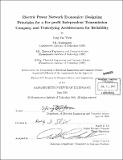Electric power network economics : designing principles for a for-profit independent transmission company and underlying architectures for reliability
Author(s)
Yoon, Yong Tae
DownloadFull printable version (26.92Mb)
Other Contributors
Massachusetts Institute of Technology. Dept. of Electrical Engineering and Computer Science.
Advisor
Marija D. Ilić.
Terms of use
Metadata
Show full item recordAbstract
In this thesis we examine the problem of designing architecture of an electric power network with the emphasis on transmission provision that supports various electricity market structures while ensuring the system wide reliability, following the electric power industry restructuring process. Specifically, the thesis proposes a possible regulatory incentive-based framework critical for creating a for-profit independent transmission company (ITC), and defines the role of ITC under the newly introduced regulatory framework, such that an adequate level of transmission capacity is provided for trading energy services between generators and loads over long-term. Before the restructuring process all of the electric services are provided by a so-called vertically integrated utility. A vertically integrated utility is a monopolistic entity who is responsible for meeting the region-wide demand for electricity at some acceptable quality by designing and operating entire generation, transmission and distribution assets within a regional electric power network. A vertically integrated utility fulfills its responsibilities by first projecting the demand of its customers over some period of time ( typically for the next 5 to 10 years) often assuming inelasticity. Then, based on the load projection, the utility plans for additional generation necessary for meeting the demand over the same period. Due to the lack of practical means of storing electricity and the uncertainty in equipment (both generation and transmission) availability, the adequate generation reinforcement includes not only the increase in projected demand but also the sufficient amount of reserves. Under the restructuring process, a completely new environment is created for producing, delivering and consuming electric power. A market is implemented for efficient trading of energy, and a vertically integrated utility is functionally unbundled into generation, transmission and distribution sectors by divesting the generation and distribution assets to many market participants including its affiliates. In the market the newly formed generation companies compete with other generation companies to provide energy to individual distribution companies who serve the ultimate consumer loads. The transmission asset owner and the network operator then together become a transmission provider (TP) who exists as a natural monopoly and provides network capacity to generation and distribution companies under the strict oversight of a regulator. With the introduction of a market mechanism there are a couple of new categories of uncertainties that are not encountered before the restructuring process, namely regulatory uncertainties and the market designs. It is asserted that these uncertainties play a critical role along with the well recognized uncertainties in equipment status/functionality in determining system wide efficiency as well as reliability in the operation and planning of an electric power network in the new environment. In dealing with the regulatory uncertainties, the price-cap regulation (PCR) scheme is suggested to replace the traditional cost-of-service regulation. Due to the particular characteristics of the industry including the lack of practical means of storing electricity and the lack of directly controlling the transmission path, some modifications to the conventional form of PCR scheme are necessary before actual application. In this thesis a practicable PCR scheme is proposed for regulating the operation and planning of a TP, which establishes the framework necessary for creating a for-profit ITC. In dealing with the uncertainties in market designs, the thesis introduces a usable business model for an ITC and the transmission products to be provided by this ITC. It is asserted that much of uncertainties in network usage, due to constantly changing supply and demand of the network users, can be eliminated through offering longer term transmission contracts by the ITC. A liquid market for these transmission contracts is essential for information revelation on the supply and demand of network users. The thesis proposes a workable mechanism for designing the market for transmission. In dealing with the uncertainties in equipment status/functionality, the thesis only suggests that there is a strong need for analytical tools in accurately computing the operational limit on power transfer through transmission lines within the network. Much work is needed for re-visiting the (short-term) reliability standards created under the old industry regime since various contractual agreements among the market participants now have very different interpretation on how the uncertainties in equipment status/functionality need to be handled. An active future research is urged for defining the market mechanisms essential for unbundling reliability in parallel to the functional unbundling. As attempted in this thesis, we believe that any proposed designs for electricity market structures should be examined with a clear understanding of the implications on the overall industry performance, as well as with an understanding of the implications on the individual industry participants, such as power suppliers, provider of wires, and consumers. Particular emphasis should be on understanding the long-term (in contrast to only short-term) effects of various changes on the adequacy of supply and evolution of the grid necessary to support the long-term needs of the energy markets. It will take some deep thinking and patience to get the entire electric power industry to function properly following the restructuring process.
Description
Thesis (Ph. D.)--Massachusetts Institute of Technology, Dept. of Electrical Engineering and Computer Science, 2001. Includes bibliographical references (leaves 231-237).
Date issued
2001Department
Massachusetts Institute of Technology. Department of Electrical Engineering and Computer SciencePublisher
Massachusetts Institute of Technology
Keywords
Electrical Engineering and Computer Science.